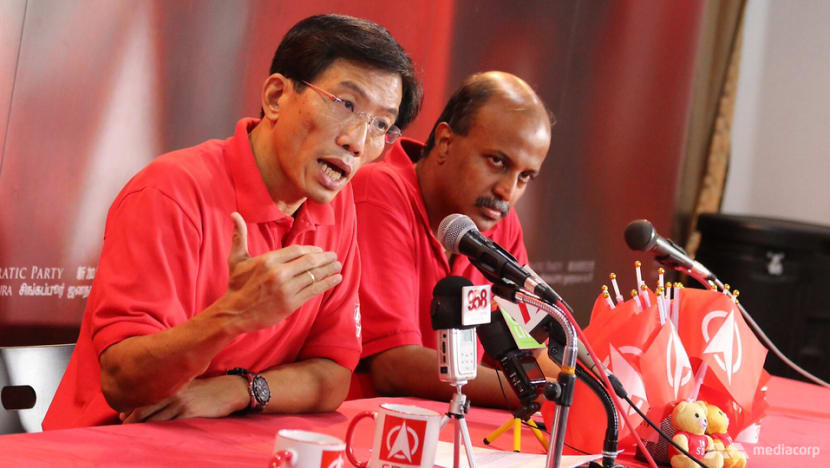Court of Appeal partially allows SDP's POFMA appeal in landmark judgment; other correction directions upheld

SDP secretary-general Chee Soon Juan and chairman Paul Tambyah speaking at a press conference on Sep 2, 2015. (File photo: Sarah Yang)
SINGAPORE: The Singapore Democratic Party (SDP) has secured a partial win in its court battle against correction directions issued under the Protection from Online Falsehoods and Manipulation Act (POFMA).
In a first, the Court of Appeal overturned part of a correction direction issued by the Ministry of Manpower against the SDP for statements it had made about unemployment in Singapore. However, the court upheld two other correction directions against SDP, as well as the other part of the third correction direction.
A 156-page landmark judgment released on Friday (Oct 8) by Chief Justice Sundaresh Menon and Appeal Judges Andrew Phang, Judith Prakash, Tay Yong Kwang and Steven Chong laid out, for the first time, a five-step framework for a court to determine whether or not to overturn a correction direction under POFMA.
The Chief Justice, who delivered the judgment, also upheld the constitutionality of POFMA and ruled that the burden of proof lay on the person making the allegedly false statement and not the minister issuing the correction direction.
This was a contentious issue in the court hearings that took place in the lower courts before the matter came to the Apex Court - with two High Court judges ruling differently - one that the minister has to prove the statement is false, and one that the respondent has to prove his statement is true.
Chief Justice Menon also disagreed with the Attorney-General's argument that a falsehood remains a falsehood even before a court determines it is false. He said it is "untenable" that a statement is declared false because the minister has identified it to be so.
"The minister may, after all, be mistaken," he said. "Truth and falsehood are ultimately matters to be determined by a court based on the evidence."
THE SDP CASE
SDP received three correction directions from the Ministry of Manpower in December 2019 for three posts: An online article published in June 2019 titled SDP Population Policy: Hire S'poreans First, Retrench S'poreans Last; a Facebook post in November 2019 linking to the above article; and a Facebook advertisement in December 2019 containing a link to the article and a graph with a downward-pointing arrow titled Local PMET Employment.
MOM said that SDP's graph showing plunging employment of local professionals, managers, executives and technicians (PMETs) was false, giving statistics to show that local PMETs employment had risen steadily since 2015.
It also said SDP's statement that its proposal comes "amidst a rising proportion of Singaporean PMETs getting retrenched" was also false.
SDP and its lawyer Suresh Nair turned to the court to set aside the three correction directions it received, arguing on various grounds including that the burden of proof was on the minister or AGC, and that what the minister claims SDP said may not be what SDP meant.
SDP had failed in its attempts to override the correction directions at every stage before this - the minister rejected its response, and the High Court dismissed its first challenge.
The correction direction that SDP partially succeeded in appealing against was based on a December 2019 Facebook advertisement. SDP put up the ad containing a link to an older article titled: SDP Population Policy: Hire S'poreans First, Retrench S'poreans Last.
The ad also contained a graph with a downward-pointing arrow titled Local PMET Employment.
THE MEANING OF "LOCAL"
The Court of Appeal set aside part of the correction direction on the grounds that what the minister claimed the graph meant was not made out in the graph.
The minister believed the graph made a false statement that the employment of PMETs who are either Singapore citizens or Singapore permanent residents had gone down. However, the court found that the readers of the post would have understood "local" in the graph to mean only Singapore citizens.
Chief Justice Menon noted that the overall thrust of the SDP article was to provide solutions targeted at Singaporeans who were displaced from PMET jobs by foreigners, and did not mention Singapore permanent residents.
The court upheld the second part of the correction direction, as a false statement claiming that local PMET retrenchment has been increasing was contained in the SDP article linked in the December 2019 post.
Data from the Manpower Ministry shows an increase in the number of local PMETs employed from 2015 to 2018 both in terms of absolute numbers and also as a proportion of all local employment.
The judgment also touched on another POFMA case involving The Online Citizen - that, though separate, was heard together with SDP's case. The court dismissed TOC's appeal entirely.














